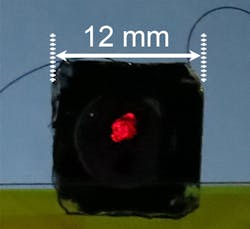Scientists at King's College London have engineered a new nanoscale device that creates a controlled stream of 'hot electrons'--high-energy electrons that allow unusual chemical reactions to take place. This could open up new research avenues for pharma, chemicals, and materials industries.
RELATED ARTICLE: Electron scattering of high-intensity laser photons sparks new behavior in light
The research, published in Nature Nanotechnology on 11 December 2017, describes how a metamaterial--a material with properties not found in nature--can be constructed that uses quantum effects to turn electrons flowing through a circuit into hot electrons and light, in a highly controlled manner. This has a wide variety of novel applications in optoelectronics, sensing, and chemistry.
The device takes advantage of a quantum effect called electron tunnelling to produce streams of particles which can have important applications, when properly controlled. A voltage is applied across the device, causing a flow of electrons from one material (eutectic gallium indium) to another (gold nanorods). These are separated by an air gap, which would usually stop the electron flow. But when the air gap is less than a nanometer, quantum mechanical rules apply, which allow the electrons to ‘tunnel’ through.
This tunnelling produces two useful effects. Firstly most of the tunnelling electrons arrive in the gold nanorod tips in the form of 'hot electrons'. Hot electrons are of great interest to chemical industries, since their high energies allow chemical reactions to occur between molecules which would not normally react with each other.
Secondly, a small proportion of the tunnelling electrons excite other particles (called plasmons) in the metamaterial. These excitations emit light, the wavelength of which is directly related to the applied voltage. Usually this conversion is very inefficient, but the King's metamaterial uses array gold nanorods providing one hundred billion tunnel junctions to improve the electron-to-plasmon conversion, making the emitted light visible to the naked eye.
The creation of hot elections is very useful to a wide range of industries that are interested in creating new chemicals that do not occur under normal conditions. For example they could be used to synthesise new molecules in pharma and chemical industries which require high energies. It can work as a lab-on-a-chip device for developing and understanding new chemical reactions where precise stimulation and monitoring are paramount.
The tunnel junctions (the air gap) in the material are very sensitive to changes. For example the new products from a chemical reaction in the junctions will dramatically affect the tunnelling properties, changing the flow of electrons, so its presence can be detected by monitoring the change in current or light. This means the materials can also be used to closely monitor the reactions it is enabling.
Similar principles can be applied for monitoring the presence of gasses. The King's material was designed to be sensitive to hydrogen and oxygen, two chemicals where there is a great need for sensitive monitoring, and was shown to reliably detect these chemicals. Detecting hydrogen leaks is important in the production of fuel cells, and monitoring the presence of oxygen is vital in a wide variety of controlled chemical reactions, such as in the manufacture of drugs.
The material can be modified to be sensitive to different molecules, making it viable as a highly sensitive, cheap, and easy to use sensor which provides visual feedback when a molecule is detected.
A further benefit of the material is in small scale electronics. Since light is generated by applying a voltage along the nanorod which is only ten nanometers thick, it can be used to optically transmit information (1s and 0s produced by rapidly turning the light on and off) between or within microchips.
This is usually done with semiconductor lasers, but as electronics get smaller the semiconductor devices become too bulky. The King's metamaterial allows the optical signals to be produced with a much smaller device, bringing advantages to chip manufacturers and facilitating the development of ever faster electronics.
SOURCE: King's College London; https://www.nature.com/articles/s41565-017-0017-7

